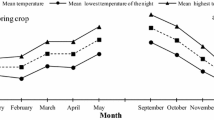Abstract
A study was made to gain greater understanding of the development of translucent end tubers which caused problems for french fry processors duringthe processing season of 1971–72. Analysis of seven commercial and three experimental samples revealed a lower dry matter and higher reducing sugar content in the basal portion of the tubers. Normally Russet Burbank potatoes contain higher dry matter in the basal end. A study of dry matter changes during growth and development in 1971 and of moisture stressed potatoes in 1972 showed a reversal in dry matter content and an uneven distribution of reducing sugars, whereas the normally irrigated potatoes maintained a higher percentage of dry matter in the basal portion throughout. A decrease in pH of the tissue accompanied the loss of starch from the basal portion of moisture stressed potatoes. As postulated by other research workers, the loss of dry matter is attributed to initiation of active growth of the apical end, thereby utilizing carbohydrates from the basal end following a period of stress. Immaturity of tubers and storage at low temperatures immediately after harvest caused water stressed potatoes to develop increased numbers of translucent ends in storage.
Similar content being viewed by others
Literature Cited
Iritani, W. M., L. Weiler and T. S. Russell. 1973. Relative differences in sugar content of basal and apical portions of Russet Burbank potatoes. Amer. Potato J. 50:24–31.
Kunkel, Robert. 1957. Factors affecting the yield and grade of Russet Burbank potatoes. Colorado State Univ. Tech. Bull. No. 62, June 1–42.
Kunkel, R. and W. H. Gardner. 1958. Blackspot of Russet Burbank potatoes. Amer. Soc. Hort. Sci. 73: 436–444.
Lugt, C. 1960. Second growth phenomena. Eur. Potato J. 3: 307–325.
Murphy, Paul A. 1936. Some effects of drought on potato tubers. Empire J. Exp. Agr. 4: 230–246.
Nielson, L. W. and W. C. Sparks. 1953. Bottleneck tubers and jelly-end rot in the Russet Burbank potato. Univ. of Idaho Res. Bul. 23 October 1–24.
Penman, F. 1929. Glassy end of potatoes. Jour. Dept. of Agr. Victoria 27: 449–458.
Pratt, O. A. 1916. A Western field rot of the Irish potato tuber caused byFusarium radicicola. Jour. of Agr. Res. VI. May 297–310.
Reeve, R. M., M. L. Weaver and H. Timm. 1971. Anatomy and compositional variation within potatoes IV. Total solids distribution in different cultivars. Amer. Potato J. 48. 269–277.
Weaver, M. L., E. Hautala and W. M. Iritani. 1970. Studies on sugar end in Russet Burbank potatoes. Abst. of paper presented at 54th annual meeting of Potato Assn. of America. Amer. Potato J. 47: 353.
Author information
Authors and Affiliations
Additional information
Washington State University College of Agriculture Research Center Scientific paper 4004, project 1949.
The, work was supported in part by funds provided by the Washington State Potato Commission.
Rights and permissions
About this article
Cite this article
Iritani, W.M., Weller, L. The development of translucent end tubers. American Potato Journal 50, 223–233 (1973). https://doi.org/10.1007/BF02849356
Received:
Issue Date:
DOI: https://doi.org/10.1007/BF02849356




